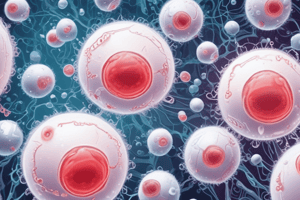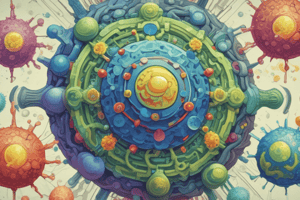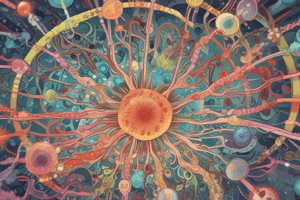Podcast
Questions and Answers
What is the primary function of the immunosuppressive cytokine IL-10 produced by regulatory T cells?
What is the primary function of the immunosuppressive cytokine IL-10 produced by regulatory T cells?
- To enhance the respiratory burst in macrophages.
- To activate B cells to produce antibodies.
- To promote the differentiation of T cells into killer T cells.
- To suppress the activity of other immune cells. (correct)
How does Oclacitinib (Apoquel) interfere with cytokine signaling to alleviate allergic signs?
How does Oclacitinib (Apoquel) interfere with cytokine signaling to alleviate allergic signs?
- By enhancing the production of interferons to combat viral infections.
- By inhibiting JAK proteins, thus disrupting the cytokine signaling pathway. (correct)
- By blocking TNF-alpha directly to prevent cell death.
- By directly neutralizing IL-4, preventing B cell growth.
Why is the controlled balance between TH1 and TH2 responses crucial for effective immunity?
Why is the controlled balance between TH1 and TH2 responses crucial for effective immunity?
- To prevent any activation of macrophages, avoiding tissue damage.
- To ensure the exclusive activation of B cells for antibody production.
- To uniformly stimulate all aspects of the immune system regardless of the type of pathogen.
- To tailor the immune response to the specific type of infection, optimizing pathogen clearance. (correct)
What is the function of perforin released by cytotoxic T cells?
What is the function of perforin released by cytotoxic T cells?
How do killer T cells identify and target virus-infected cells within tissues?
How do killer T cells identify and target virus-infected cells within tissues?
In the context of T cell activation, what occurs if a T cell encounters an antigen without a co-stimulatory signal?
In the context of T cell activation, what occurs if a T cell encounters an antigen without a co-stimulatory signal?
How do Pattern Recognition Receptors (PRRs) on dendritic cells influence CD4 T cell differentiation?
How do Pattern Recognition Receptors (PRRs) on dendritic cells influence CD4 T cell differentiation?
What is the role of CD3 protein complex in T cell activation?
What is the role of CD3 protein complex in T cell activation?
What is the purpose of T cells visiting secondary lymphoid organs?
What is the purpose of T cells visiting secondary lymphoid organs?
Which of the following is a function of TH17 cells in mucosal epithelial immunity?
Which of the following is a function of TH17 cells in mucosal epithelial immunity?
Which characteristic distinguishes induced regulatory T cells from natural regulatory T cells?
Which characteristic distinguishes induced regulatory T cells from natural regulatory T cells?
How do cytokines primarily exert their effects on target cells?
How do cytokines primarily exert their effects on target cells?
What is the importance of co-stimulation (CD28/CD80-86 interaction) in T cell activation?
What is the importance of co-stimulation (CD28/CD80-86 interaction) in T cell activation?
What is the role of high endothelial venules (HEVs) in lymphocyte trafficking?
What is the role of high endothelial venules (HEVs) in lymphocyte trafficking?
How do granzymes contribute to the destruction of virus-infected cells?
How do granzymes contribute to the destruction of virus-infected cells?
What distinguishes the function of CD4+ T cells from CD8+ T cells in adaptive immunity?
What distinguishes the function of CD4+ T cells from CD8+ T cells in adaptive immunity?
What is the role of FAS ligands on cytotoxic T cells in eliminating infected cells?
What is the role of FAS ligands on cytotoxic T cells in eliminating infected cells?
Which cells express T cell receptors (TCRs) that recognize antigen fragments presented by dendritic cells in the lymph node paracortex?
Which cells express T cell receptors (TCRs) that recognize antigen fragments presented by dendritic cells in the lymph node paracortex?
What is the significance of the interaction between CD40L on T helper cells and CD40 on B cells?
What is the significance of the interaction between CD40L on T helper cells and CD40 on B cells?
After activation in secondary lymphoid tissues, how do T cells exit and re-enter circulation to locate infected tissues?
After activation in secondary lymphoid tissues, how do T cells exit and re-enter circulation to locate infected tissues?
How does the cytokine IFN-gamma, released by TH1 cells, enhance macrophage function?
How does the cytokine IFN-gamma, released by TH1 cells, enhance macrophage function?
What is the immediate consequence of IL-2 secretion by newly activated T cells?
What is the immediate consequence of IL-2 secretion by newly activated T cells?
How do B cells, after being produced in the bone marrow, prepare to respond to an infection?
How do B cells, after being produced in the bone marrow, prepare to respond to an infection?
What is the primary target of CD8 T cells after differentiation and activation?
What is the primary target of CD8 T cells after differentiation and activation?
Which type of infection would primarily require a TH2-dominated response?
Which type of infection would primarily require a TH2-dominated response?
What is the function of memory T cells in long-term immunity?
What is the function of memory T cells in long-term immunity?
What is the role of the cytokine IL-4 in adaptive immunity?
What is the role of the cytokine IL-4 in adaptive immunity?
How does the drug Ciclosporin (Atopica) affect T cell function?
How does the drug Ciclosporin (Atopica) affect T cell function?
Which MHC class do CD4 T cells interact with and what type of infection do those peptides come from?
Which MHC class do CD4 T cells interact with and what type of infection do those peptides come from?
Flashcards
Thymus
Thymus
T cells migrate here to differentiate into Helper, Regulatory, and Killer T cells.
B cells
B cells
These cells stay in the bone marrow and migrate to secondary lymphoid tissues to produce plasma cells during infection.
High Endothelial Venules (HEVs)
High Endothelial Venules (HEVs)
Lymphocytes leave the circulation and enter lymph nodes.
Interdigitating dendritic cells
Interdigitating dendritic cells
Signup and view all the flashcards
Third law of immunity
Third law of immunity
Signup and view all the flashcards
MHC Class I
MHC Class I
Signup and view all the flashcards
MHC Class II
MHC Class II
Signup and view all the flashcards
Calcineurin
Calcineurin
Signup and view all the flashcards
Ciclosporin (Atopica)
Ciclosporin (Atopica)
Signup and view all the flashcards
Danger Signals
Danger Signals
Signup and view all the flashcards
T cell anergy
T cell anergy
Signup and view all the flashcards
Interleukin 2 (IL-2)
Interleukin 2 (IL-2)
Signup and view all the flashcards
Cytokines
Cytokines
Signup and view all the flashcards
STAT proteins
STAT proteins
Signup and view all the flashcards
Oclacitinib (Apoquel)
Oclacitinib (Apoquel)
Signup and view all the flashcards
Killer T cells
Killer T cells
Signup and view all the flashcards
Perforin
Perforin
Signup and view all the flashcards
Granzymes
Granzymes
Signup and view all the flashcards
Pathogen-Associated Molecular Patterns (PAMPs)
Pathogen-Associated Molecular Patterns (PAMPs)
Signup and view all the flashcards
Pattern-recognition receptors (PRRs)
Pattern-recognition receptors (PRRs)
Signup and view all the flashcards
IL-12
IL-12
Signup and view all the flashcards
TH2 helper T cells
TH2 helper T cells
Signup and view all the flashcards
TH17 cells
TH17 cells
Signup and view all the flashcards
Regulatory T cells
Regulatory T cells
Signup and view all the flashcards
TH1 helper T cells
TH1 helper T cells
Signup and view all the flashcards
Study Notes
- T cells and B cells are both lymphocytes produced in the bone marrow.
- T cells migrate to the thymus for differentiation into Helper T cells, Regulatory T cells, and Killer T cells.
- B cells stay in the bone marrow and migrate to secondary lymphoid tissues for differentiation into Plasma cells upon infection.
- Lymphocytes are mobile cells that circulate in the blood and lymph, visiting secondary lymphoid organs like lymph nodes to scan for foreign antigens.
- Lymphocytes bind to receptors on High Endothelial Venules (HEVs) to exit circulation and enter lymph nodes via afferent lymphatics.
- T cells are directed to the paracortex, while B cells are directed to the follicles within lymph nodes.
- Naïve T cells in the lymph node paracortex use TCRs to recognize antigen fragments presented on interdigitating dendritic cells.
- T cells that recognize an antigen become activated and stay in the lymph node; otherwise, they exit via efferent lymphatics and re-enter the blood.
Third Law of Immunity
- The immune system regulates itself to prevent excessive or self-destructive activity.
- CD8 T cells interact with MHC Class I, presenting peptides from intracellular infections.
- CD4 T cells interact with MHC Class II, presenting peptides from extracellular infections.
T Cell Activation Signals
- T cells require multiple signals to become activated.
TCR Recognition (Signal 1)
- TCR binding to MHC causes phosphorylation of the CD3 protein complex.
- Phosphorylation activates calcineurin, increasing intracellular Ca2+ and activating T-cell receptors.
- Ciclosporin (Atopica) inhibits calcineurin action, thus inhibiting T cell activation.
Danger Signals (Signal 2)
-
Dendritic cells release danger signals after contacting pathogens, becoming APCs.
-
T cells from an infected area have CD28 receptors.
-
Danger signals induce CD80/CD86 molecules on the pathogen, which bind to the CD28 receptor, creating a signal alongside the TCR signal for co-stimulation.
-
If the antigen is harmless, no binding to the CD28 receptor occurs, leading to T cell anergy.
-
Signal 3 involves the innate immune system using PAMPs and PRRs.
-
Naïve T cells undergo clonal expansion upon initial activation.
-
Interleukin 2 (IL-2) acts as a T cell growth factor (autocrine signaling) to proliferate the T cell clone.
-
T cells differentiate into mature effector forms under IL-2.
-
CD8 T cells differentiate into killer T cells (cytotoxic T lymphocytes or CTL).
-
CD4 T cells can differentiate into helper T cells or regulatory T cells.
-
After the immune response, T cells become memory lymphocytes, providing long-term immunological memory as they patrol in the circulation.
Cytokines
- T cells produce cytokines as a key effector function.
- Cytokines are small proteins that aid cell signaling, acting as immunological hormones.
- They primarily act via a local paracrine effect, but sometimes via an endocrine effect.
Examples of Cytokines
- Interleukins:
- IL-2: clonal proliferation of T cells.
- IL-4: B cell growth factor.
- IL-10: immunosuppression.
- Interferons:
- IFN alpha/IFN beta: anti-viral defense (innate immunity).
- IFN-gamma: macrophage activating factor.
- Tumor Necrosis Factor (TNF) Family:
- TNF-alpha: cell killing.
Cytokine Receptor Signalling
- JAK/STAT pathway:
- Cytokines released from immune cells bind to receptors on the cell surface, activating JAK proteins.
- JAK proteins activate STAT proteins.
- STATs enter the nucleus to switch genes on.
- Oclacitinib (Apoquel) selectively inhibits JAKs, blocking the cytokine signaling pathway and blocking IL-31 receptors on nerve cells.
- Ilunocitinib (Zenrelia) is less selective but also inhibits JAKs.
CD8 Killer T Lymphocytes
- Killer T cells differentiate from CD8 T cells in secondary lymphoid tissues.
- These T cells leave secondary lymphoid tissues and enter the circulation to find infected tissues.
- Killer T cells have altered homing receptors to target inflamed endothelium.
- Upon contact with an infected cell, they kill the cell via three pathways:
Cytokines Release
- JAK/STAT pathway is activated.
- Macrophages are activated and B-cells are assisted.
Cytotoxic Granules
- Contain perforin that forms pores in the cell membrane, allowing granzymes to enter the target cell.
- Granzymes activate the caspase cascade, causing cell death and stopping viral replication.
FAS Ligands
- Cytotoxic cells have FAS ligands, which bind to FAS receptors on normal cells.
- This activates a self-destruction sequence.
Innate Immune System Impact
- Pathogen-Associated Molecular Patterns (PAMPs) are molecular structures found in pathogens but not host cells that can be detected as foreign.
- Pattern-recognition receptors (PRRs) detect PAMPs.
- Dendritic cells have PRRs that induce the expression of CD80/CD86.
- Different PRRs induce different cytokine patterns, influencing CD4 T cell differentiation (signal 3).
- Bacteria acts on PRR 1, which causes the release of IL-12 to T cells, which then become CD4 T helper type 1 cells.
- Parasites act on PRR 2, which causes the release of IL-4 to T cells, which then become CD4 T helper type 2 cells.
CD4 T Cell Sub-Populations
- CD4 T cells can differentiate into several types with different roles.
- Most important are T Helper 1's and T Regulatory 1's.
- Dendritic cells release a danger signal (signal 2) to help differentiate the T cells into helper T cells.
T Helper Cells
- There are 2 main types of CD4 T-helper cells:
TH1 Helper T Cells
- Macrophages interact with TH1 cells.
- They release IFN-gamma, a macrophage activation factor, which helps:
- The respiratory burst: increased Oxygen free-radicals, Nitric Oxide production, anti-microbial peptides and proteases. This enhances cellular aerobic metabolism for oxidative killing.
- Increased lysosomal digestion.
- Important in vesicular infections where pathogens deliberately infect macrophages (e.g. mycobacteria such as TB).
TH2 Helper T Cells
-
B-cells interact with TH2 cells.
-
These activate B cells to make antibodies that are specific to the type of infection (e.g., IgG vs IgA vs IgE).
-
Without the help of TH2's, only IgM are produced for a short period of time.
-
The balance between TH1's and TH2's is important.
-
In most infections, an equal amount of both TH1's and TH2's is needed.
-
In vesicular infections of macrophages (e.g., mycobacterium bovis), TH1's are more important, TH2's are useless.
-
In parasitic infections, TH2's are more important than TH1's.
-
E.g., in parasitic infections, IgE antibodies are needed instead of IgM antibodies, TH1's are useless.
TH17 Cells
- These cells release IL-17
- They are used in mucosal epithelial immunity.
- When mucosal surfaces have been infected by bacteria or fungi, IL-17 activates epithelial cells to secrete anti-microbial peptides into the lumen and chemokines basally that draw the neutrophils to the area for phagocytosis of bacteria and fungi.
Regulatory T Cells
- These are the 'military police' of the immune system.
- They produce immunosuppressive cytokines like IL-10 and TGF-beta.
- Natural regulatory T cells are regularly produced from the thymus.
- Induced regulatory T cells are produced on demand in an infection.
Memory T Cells
- Not all activated T cells become T killer/T helper/T regulatory cells.
- Towards the end of an immune response, some cells differentiate into memory cells.
- Memory cells express the same homing receptors as naïve T cells and enter the circulation as immune surveillance.
Studying That Suits You
Use AI to generate personalized quizzes and flashcards to suit your learning preferences.




